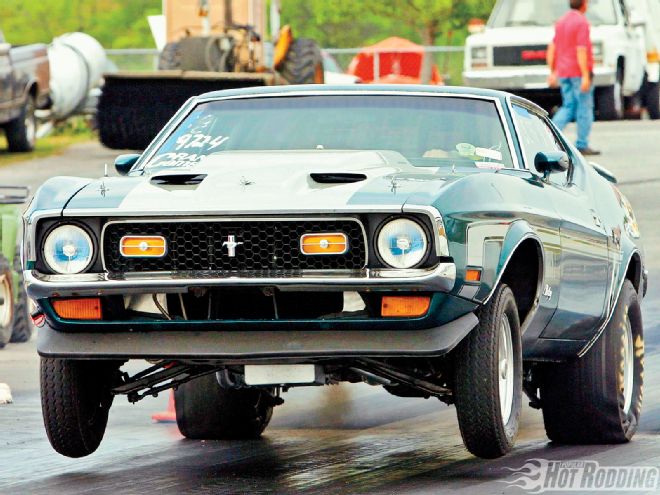
There are several unsung ingredients required in the recipe for any high-performance engine to perform safely to its potential, but one of the least understood is fuel. For a surprising number of hot rodders and racers, their understanding starts and ends with the typical 87-, 89-, and 91-octane numbers on the fuel pump. Even the R+M/2 formula just above each number is a mystery to most. We're here to rectify that, because what kind of go-juice you run through your engine can mean the difference between getting the most out of your engine or being forever limited below its potential. And in the worst-case scenario, it could be the difference between safely churning out power and catastrophe.
At our annual festival of horsepower, the AMSOIL Engine Masters Challenge, we pull together some of the top engine builders in the country, give them a set of parameters to follow, and let them create the best engines their years of experience can produce. It's always an amazing assortment of engines that run the spectrum from Y-block to LS. However, no matter how good the engine is on paper, it'll fall flat or eat itself on the dyno without proper fueling. That's because at this level of power extraction, all the variables need to be known, so we provide a spec fuel for each class: Street gets VP100, and Xtreme Street gets Q16 from VP Racing Fuels (VP).
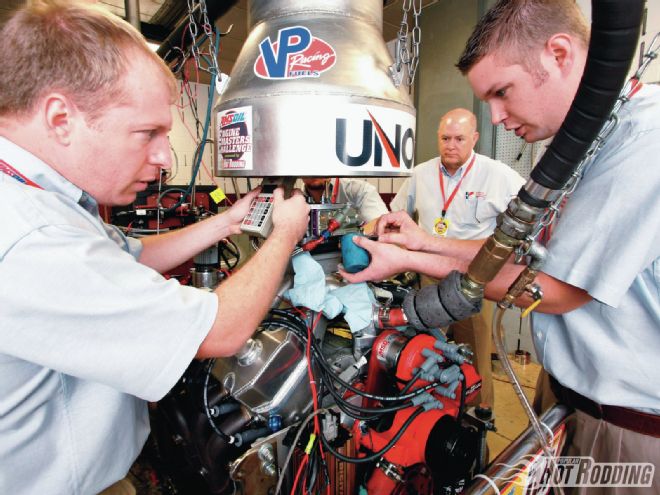 When it comes to getting the absolute most out of any engine combination, the right fuel choice is critical. Just ask the competitors at EMC, they all rely on VP Racing fuel to be precise and consistent for max power production and protection of their investment.
When it comes to getting the absolute most out of any engine combination, the right fuel choice is critical. Just ask the competitors at EMC, they all rely on VP Racing fuel to be precise and consistent for max power production and protection of their investment.
Race Fuel vs. Pump Fuel
What is the main difference between street and race fuel? Well, first and foremost will be the octane rating. While daily driven commuter cars can easily putt around on 87- to 93-octane gas, the cylinder pressures found in performance and racing engines are much higher, which requires higher octane to resist engine destroying detonation. VP's fuel catalog starts at 100-octane with the unleaded 50-state legal VP100, and progresses up the ladder from there. On the unleaded side, VP has many options that climb all the way up to MS109. Of course lead isn't allowed in pump gas for a variety of health and environmental reasons, and it's also pretty hard on oxygen sensors and catalytic converters and will significantly shorten their lives. It's still the best-known blending component for suppressing detonation, so it's still allowed in race-only fuels where compression ratios can reach 18:1 or more, and where huge boost numbers or nitrous shots require such stability. VP's leaded fuel catalog is extensive, covering any application imaginable all the way up to C23 which has an octane rating that's off the testable scale at 120-plus.
Those big numbers are great, but only if you can rely upon them to be consistent. "Pump gas can vary region to region, season to season, even station to station on the same day across the street from each other. You basically never know what blend you're getting day to day," Steve Scheidker at VP explained to us. "By contrast, race fuel in general, and VP fuels in particular, are consistent from drum to drum, pail to pail, regardless of where or when you buy them. Consistency is a VP hallmark; you can always count on a particular fuel blend having the same characteristics as the last time you bought it." That may not be a big deal for factory-tuned or very mildly modified street cars, since the factory ECU can and does compensate for fuel fluctuations, but it's very different for highly modified cars that have been custom tuned.
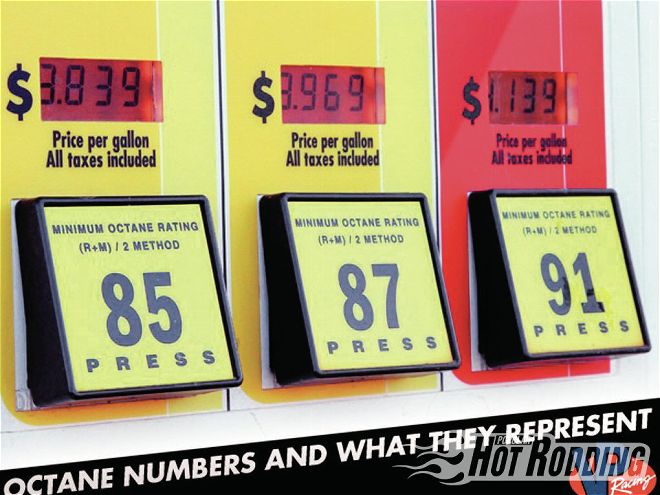 You may be fortunate enough to have 92- or even 93-octane where you live, but in SoCal 91 is the best we get. Those numbers are pretty deceptive, though; every hot rodder needs to know what they really mean.
You may be fortunate enough to have 92- or even 93-octane where you live, but in SoCal 91 is the best we get. Those numbers are pretty deceptive, though; every hot rodder needs to know what they really mean.
Also, remember that pump gas is blended with the cheapest components possible to meet the minimum government-mandated standards to maximize profit. Race fuels are designed from scratch with only the highest-quality components to maximize power and performance for each specific application, with cost only a secondary consideration. That's why the stuff is so much more per gallon than pump fuel. But in the final analysis, race fuel often generates more performance gains per dollar invested than many hard parts, because it lets you maximize your combination to its potential.
That careful attention to components shows up most in the distillation curve. Vaporization and atomization is how you make more power; liquid doesn't burn, we need vapor. The distillation curve refers to the rate at which all the components in a fuel vaporize. Ideally, for maximum energy per combustion we want droplets of fuel to turn to vapor as soon as the intake valve closes. Street-driven engines spend much of their time at low rpm ranges and have a much longer window of time to get heat into the combustion chamber and burn components, so heavier components will be chosen to create a smoother curve. Some of those components may require 300-400 degrees F to vaporize and burn. In performance and racing engines where engine speed is much higher, the time available to burn the fuel drops dramatically so racing fuels will begin to vaporize around 100 degrees F and will completely vaporize by around 250 degrees F. Racing fuels are blended with that in mind: vaporize quickly and burn completely at lower temperatures under high cylinder pressure to extract the most power possible while leaving little unburnt material. Jason Rueckert, a Tech Specialist at VP, says their Q16 blend may be the best vaporizing race fuel in the world with nearly instantaneous vaporization in the combustion chamber.
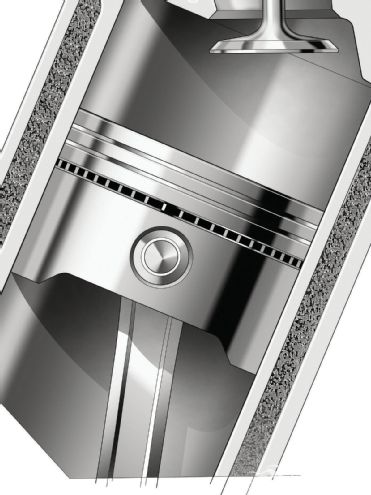 Liquid doesn’t burn, so in an ideal world all of the fuel components need to vaporize in the combustion chamber as soon as the intake valve closes so that it burns completely in milliseconds.
Liquid doesn’t burn, so in an ideal world all of the fuel components need to vaporize in the combustion chamber as soon as the intake valve closes so that it burns completely in milliseconds.
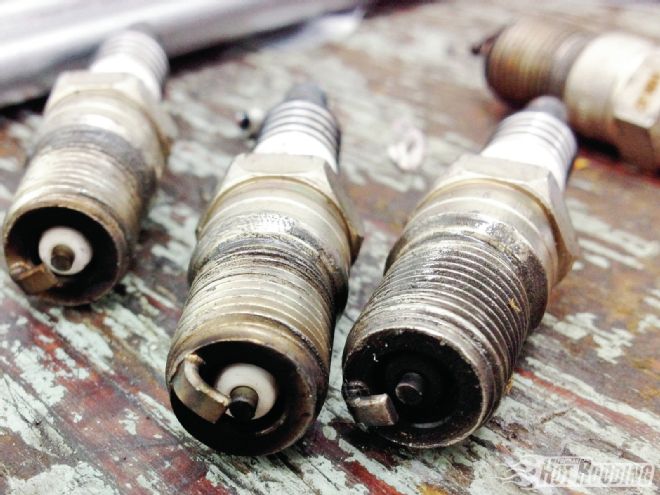 No matter how technology progresses, being able to accurately read your plugs is never going away. There really isn’t anything that can give you a more immediate and accurate picture of what’s going on inside the chamber.
No matter how technology progresses, being able to accurately read your plugs is never going away. There really isn’t anything that can give you a more immediate and accurate picture of what’s going on inside the chamber.
Fuel Ratings
So, let's break it down a bit; how is fuel rated? We've all seen octane numbers on pump and race fuel, but what does "octane" actually mean? Simply put, the octane rating is still just a knock threshold value of the fuel, or its resistance to detonation. Many fuels are referred to using the R+M/2 number. That's the Motor Octane Number (MON) + the Research Octane Number (RON) divided by 2. You've likely seen this Anti-Knock Index (AKI) or Pump Octane Number (PON) on any given fuel pump, usually right next to the octane number on the selection button.
What the heck does that mean? We'll use one of our favorite fuels from VP, MS109, as an example. Below is the Typical Values chart you'll see next to any VP fuel.
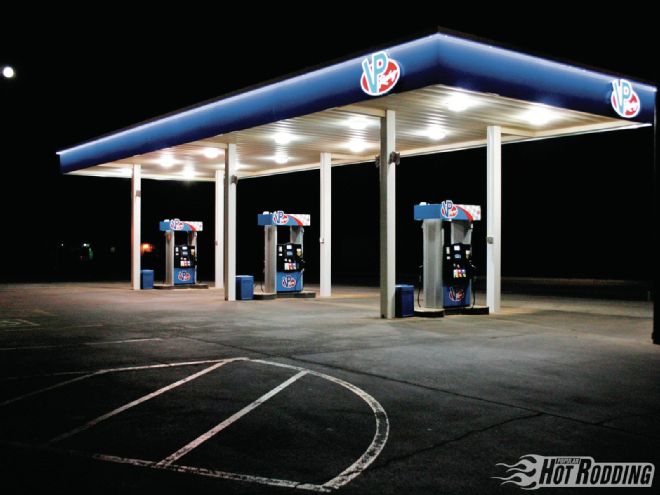 Only two exist now, but with the support of hot rodders and racers, VP Fuel stations will soon pop up around the country offering much higher quality and consistent alternatives to standard pump fuel.
Only two exist now, but with the support of hot rodders and racers, VP Fuel stations will soon pop up around the country offering much higher quality and consistent alternatives to standard pump fuel.
Color: Despite octane or intent, fuel looks more or less the same, so coloration is added simply to help differentiate the different blends both for easy identification by hot rodders and racers, as well as tech inspectors.
Research Octane: This is the octane rating given by a Research Octane Engine (ROE). Designed in the 1930s, this single cylinder engine resembles an ancient Briggs & Stratton and operates at 600 rpm with an intake temp of 120 degrees F, and timing fixed at 13 degrees. It uses an adjustable cylinder head that can move up or down to increase or lower the compression ratio while the engine is running. The point at which the fuel being tested begins to detonate is its Research Octane Number.
Motor Octane: This is octane rating given by a Motor Octane Engine (MOE). This machine, also designed in the 1930s, is similar in design to the ROE, except that it runs at a steady 900 rpm, uses an intake temp of 300 degrees F, and features variable timing with a base setting of 26 degrees. It also uses an adjustable head to vary compression ratio to determine the point of detonation. The MOE test puts much more stress on the fuel and can more closely resemble the loads on a performance or racing engine, so it will always be lower than the RON, and is the value racers pay the most attention to.
R+M/2: This is the Research Octane number added to the Motor Octane number and divided by two. This is the standard rating method for all street pump gasoline that you will find at any given U.S. station (in Australia and most of Europe, the octane rating shown on the pump is the RON, but in Canada, the United States, Brazil, and some other countries, the pump number is R+M/2). Why? Mostly for marketing purposes. The RON will always be significantly higher than the MON, so the two are averaged together. Per VP in-house testing, standard pump 92-octane has a MON of about 86, while 87 is really more like 79 MON. Think about that next time you ponder saving a few cents and hose down your pride and joy with 87!
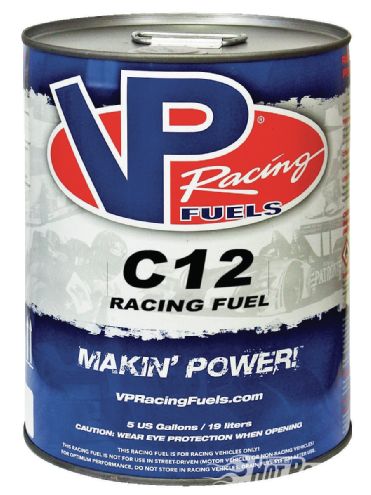 Every racer knows C12; this stuff has been a standard at racetracks since the 1970s and is still a favorite fuel today.
Every racer knows C12; this stuff has been a standard at racetracks since the 1970s and is still a favorite fuel today.
Specific Gravity: A fuel's specific gravity is its weight compared to water at 60 degrees F. Water is 1.00 on the scale, so since fuel is less dense the number will always be a decimal. Knowing this is vital to tuning the engine because it provides reference point for tuners to base fuel flow. For example, MS109 is .722, while the 50-state legal VP100 is .746. If you were to tune your engine to run VP100 on the street, but decided to switch to MS109 for a more aggressive tune on a track day, the lower Specific Gravity denotes that it's a lighter fuel, which would cause the engine to run leaner with the same tune. To compensate, more fuel should be added in to get the air/fuel ratio (AFR) back into the target zone.
Stoichiometric Value (Stoich): The "stoich" is related to the AFR since a fuel at a stoichiometric mixture has just enough air to completely burn. Factory EFI tunes use the value to control emissions, while aftermarket EFI controllers use it as another tuning parameter. The stoich value is really only valuable under light-load cruising conditions, though, since the 14.7:1 (14.7 grams of air per 1 gram of fuel) established by the EPA (gasoline's stoich is truly closer to 13:1) burns extremely hot and is too lean for acceleration or any other loading on the engine. Attempting to maintain a stoich value under hard acceleration would induce a great deal of detonation, which is why oxygen sensors are required in the exhaust of an EFI-equipped engine; they send data to adjust the AFR by adding fuel to compensate for engine load, or even different fuel blends. Carburetor-equipped cars have to manually adjust to compensate, of course.
Motorsport 109 Typical Values Color: clear Research octane: 109 Motor octane 101 R+M/2: 105 Specific gravity: .722 at 60° F Stoichiometric value
Detonation & Compression
Speaking of detonation and compression, we'd like to clarify that the octane rating is not an indicator of the energy content of fuel, it's only a measure of the fuel's tendency to burn in a controlled manner rather than exploding in an uncontrolled manner. For example, the octane number of a fuel is raised by blending in ethanol, but its energy content per volume is reduced. So yes, you can run higher compression with E85 fuel, but it will not produce as much energy per volume of an equivalent race fuel.
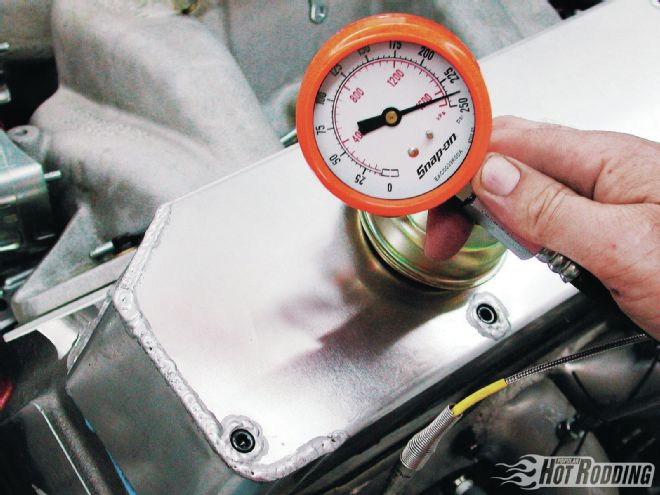 Cylinder pressure is one of the biggest considerations for fuel choice, and compression ratio is one of the biggest deciders of cylinder pressure. Cam timing can have a large effect on the actual ratio that the fuel experiences as well. With 240 psi, this engine is definitely a candidate for high-octane fuel.
Cylinder pressure is one of the biggest considerations for fuel choice, and compression ratio is one of the biggest deciders of cylinder pressure. Cam timing can have a large effect on the actual ratio that the fuel experiences as well. With 240 psi, this engine is definitely a candidate for high-octane fuel.
Of course that begs the questions, will my car make more power if a higher-octane fuel is used? Maybe. The main reason to run higher-octane fuels is to ward away detonation as the compression ratio is raised and the timing gets more aggressive. On a straight octane-to-octane comparison, there is a point at which higher octane will not benefit your car. Just as it's very possible to "under-octane" an engine and lose power or cause mechanical damage, you can also "over-octane" an engine and create a situation where the fuel isn't responding to the conditions your engine presents.
Picking A Fuel
So now that you will have a basic grasp of what you're looking at when studying an extensive list of fuel offerings such as those aforementioned 70-plus fuels on VP's website, we'll get to the real question we know you want answered: What fuel do I need for my car? The good news is that unless you are a hard-core racer or run in a class with a spec fuel, you can ignore most of the offerings that are tailored to those guys. Many blends were created by VP specifically to meet a certain race class' standards, while many others exist simply as lower cost alternatives for racers on tight budgets.
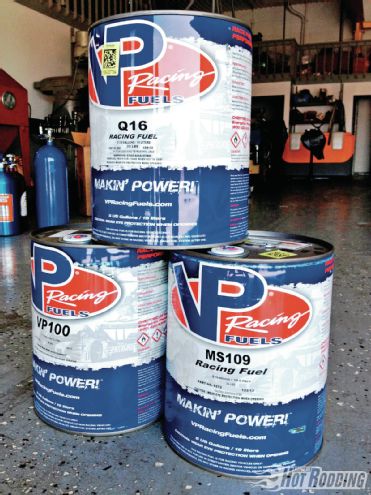 Confused on what to get? According to Rueckert at VP, this is the tower of power that will cover the majority of street hot rodders and street/strip/track day racers not governed by class rules. Add 113, if you’d like to run the leaded fuel equivalent of MS109.
Confused on what to get? According to Rueckert at VP, this is the tower of power that will cover the majority of street hot rodders and street/strip/track day racers not governed by class rules. Add 113, if you’d like to run the leaded fuel equivalent of MS109.
Using the advice of Rueckert, we narrowed the choices down to a few that should encompass the vast majority of the rodders out there, as well as a few representative applications. Unleaded: VP100, MS109. Leaded: VP110, VP113, C16, and C25. Check VPRacingFuels.com for the full spec sheet on these or go to PopularHotRodding.com. The biggest rule of thumb when choosing? Learn to read your plugs, and always err on the side of safety. The second biggest? Call the tech experts at VP and discuss your platform.